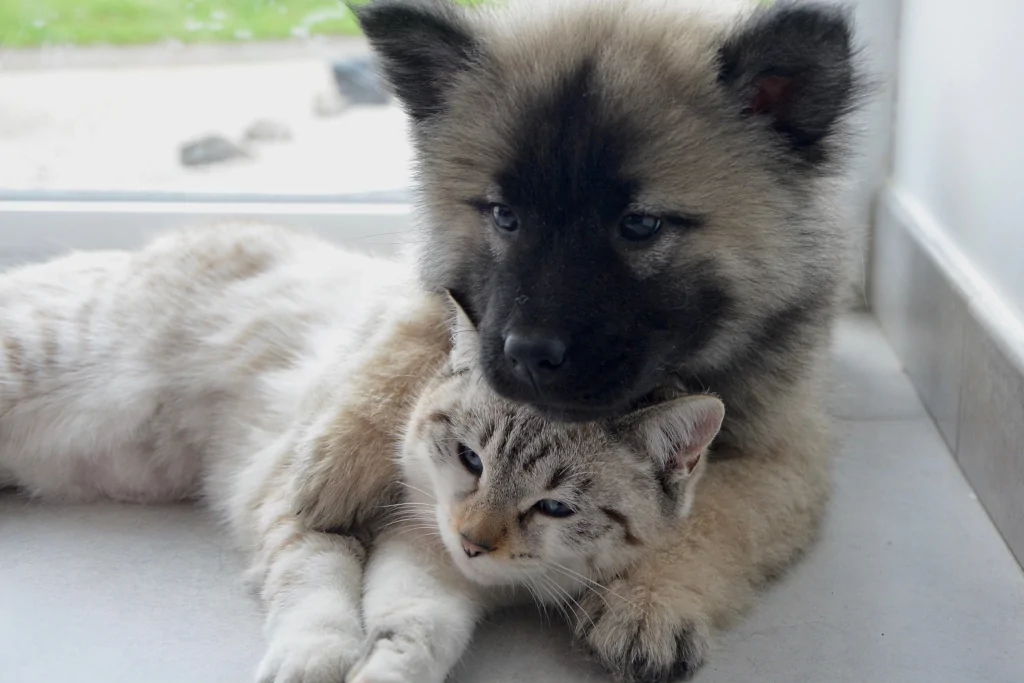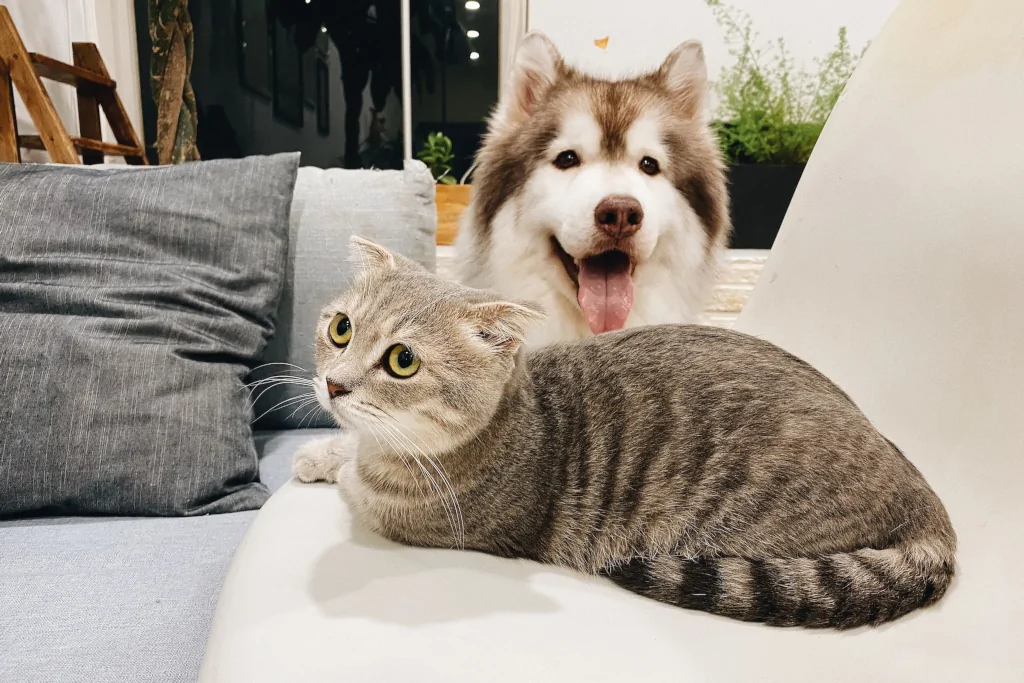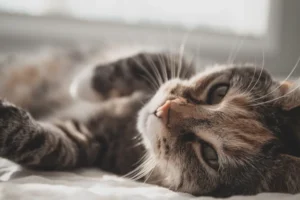Disclosure: We may earn a commission from helpful, relevant links in our content. No cost to you. See our privacy policy.
Do you dream of a peaceful home where your male cat and male dog coexist in harmony, but worry that it’s just a far-fetched fantasy?
Fret not, because making this dream a reality is possible with the right approach and some helpful strategies.
In this article, we’ll explore essential factors like breed, temperament, and compatibility, as well as practical tips to ensure a smooth and successful introduction between your feline and canine companions.
So, buckle up and get ready to transform your home into a haven of interspecies friendship, where fluff and fur unite!

Cat-Dog Cohabitation
While the age-old tale of cats and dogs being mortal enemies has been debunked, achieving a peaceful cohabitation between a male cat and a male dog still requires careful consideration and planning.
The key to success lies in understanding the unique personalities and needs of both pets, and taking gradual steps to help them adapt to each other’s presence.
With patience, persistence, and positive reinforcement, you can create a harmonious living environment for your furry friends.
Breed, Temperament, and Compatibility Factors
When considering cat-dog compatibility, it’s crucial to take into account the specific breed, temperament, and behavioral traits of your pets.
Certain dog breeds, like Golden Retrievers and Labradors, are known to be more cat-friendly, while others might require extra effort to establish a peaceful coexistence.
Likewise, some cat breeds, such as Maine Coons and Ragdolls, have more laid-back personalities that may gel well with canine companions.
Cat-friendly dog breeds:
- Golden Retrievers
- Labradors
- Poodles
- Beagles
- Boxers
- Cavalier King Charles Spaniels
- Basset Hounds
Laid-back cat breeds:
- Maine Coons
- Ragdolls
- British Shorthairs
- Persians
- Russian Blues
It’s essential to understand and respect the individual needs and comfort levels of both pets to ensure a successful interspecies bond.
Gradual Introductions and Taking It Slow
Introducing a male cat and male dog to each other gradually is crucial for a successful and harmonious relationship.
By taking it slow, you give both animals the chance to adapt to each other’s presence and feel comfortable in their shared environment. Here are some specific tips for a smooth introduction process:
- Scent swapping. Before the first face-to-face meeting, familiarize your pets with each other’s scent. Exchange bedding or toys so they can get used to the smell without feeling threatened. This will help them feel more at ease when they eventually meet.
- Use barriers. Initially, keep your pets separated with a baby gate or a pet playpen. This allows them to see, smell, and hear each other without direct contact, reducing the chances of an aggressive encounter.
- Supervised interactions. When you feel it’s time for a face-to-face introduction, make sure to supervise their interaction closely. Keep your dog on a leash to maintain control, and allow your cat an escape route if they feel overwhelmed.
- Positive reinforcement. Reward both pets for calm and non-aggressive behavior during their meetings. Use treats, praise, and affection to reinforce positive interactions, helping them associate each other’s presence with positive experiences.
- Gradual increase in interaction time. As your pets begin to tolerate each other’s presence, slowly increase the duration of their interactions. Continue to supervise them until you’re confident that they can safely coexist without your intervention.
By taking these steps and being patient, you’re giving your pets the best chance to develop a harmonious relationship that will last a lifetime.

Ensuring Pet Comfort with Safe Spaces
Creating individual safe spaces for your male cat and male dog is a key factor in fostering a harmonious living environment. By providing separate areas where each pet can retreat and feel secure, you minimize potential stress and tension between them.
To make your cat feel comfortable, designate a cat-only area, preferably at an elevated location such as a high shelf or a cat tree. Cats instinctively seek high ground for safety and relaxation. Ensure that their food, water, and litter box are easily accessible in this area.
For your dog, set up a cozy space with their bed, toys, and a water dish. You can use a crate or a designated room corner to create a sense of security for your dog. Make sure the area is free from potential disturbances or distractions that could cause anxiety.
Maintaining separate spaces for both pets allows them to retreat when they need time alone, helping to prevent conflicts and promote a more peaceful coexistence.
As your pets grow more accustomed to each other, you may find them sharing spaces or even cuddling together, which is a sure sign of a successful bonding process.
Training and Socialization: Building Trust
A strong foundation of trust between your male cat and male dog is essential for a peaceful relationship. Training and socialization are key elements in fostering this bond, as they help your pets understand each other’s behavior and develop mutual respect.
For your dog, obedience training is essential. Teach them basic commands like “sit,” “stay,” and “leave it” to ensure they can respond appropriately in the presence of the cat.
Reward-based training methods, like using treats and praise, are most effective and can help create positive associations with the cat.
Socializing your cat and dog is equally important. Gradually expose them to each other’s presence through scent swapping, short supervised meetings, and shared activities such as playtime or mealtime.
This allows them to observe and learn each other’s body language, easing their communication and interactions.
As your pets become more comfortable with each other, you may notice signs of trust emerging, like your cat grooming your dog or your dog playfully bowing to the cat. These are indicators that your efforts to build trust between them are paying off, leading to a more harmonious household.
Monitoring Interactions to Prevent Conflict
Monitoring interactions between your male cat and male dog is a crucial step in ensuring harmony in your household. By paying close attention to their body language and behavior, you can identify any signs of stress or potential conflict before it escalates.
It’s important to intervene if you notice any aggressive or fearful behaviors, such as growling, hissing, or raised hackles. Distraction techniques, like using treats or toys, can be helpful to diffuse tense situations and redirect their focus.
Keep in mind that some amount of curiosity and exploration is normal as your pets learn to understand each other. Allow them to sniff and observe one another from a safe distance, while always being ready to step in if needed.
Regular monitoring and intervention will not only protect your pets but also help them build trust and a more harmonious relationship over time.
Signs Your Cat and Dog Are Bonding
As your male cat and male dog begin to coexist, it’s helpful to recognize the signs that they are forming a bond.
Positive interactions, such as mutual grooming, relaxed body language, and play sessions, are strong indicators that they’re starting to feel comfortable and secure with one another.
You may also notice your pets seeking each other’s company, napping together, or sharing resources like toys and resting areas.
Remember that the bonding process can take time and may not always be a linear progression. It’s normal for pets to have some setbacks along the way.
Consistently fostering a supportive and safe environment, while staying patient and understanding, will greatly contribute to the development of a long-lasting, harmonious relationship between your cat and dog.
Here’s a great video on proper dog and cat introduction:
FAQs
Can certain dog breeds be more likely to get along with male cats?
Some dog breeds, like Golden Retrievers and Labradors, are known to be more cat-friendly due to their gentle and sociable nature, increasing the likelihood of getting along with male cats.
How can I tell if my cat is afraid of my dog?
Signs of fear in a cat include flattened ears, arched back, hissing, growling, and attempting to hide or escape from the dog’s presence.
Is there an ideal age to introduce a male cat to a male dog?
Introducing pets at a younger age, preferably when both are under a year old, can be ideal for forming bonds, as they are generally more adaptable and open to new experiences.
How long should I expect the bonding process to take?
The bonding process can vary greatly depending on the pets’ personalities and previous experiences. It can take anywhere from a few weeks to several months for a cat and dog to develop a comfortable relationship.
Alex, a passionate animal lover, has experience in training and understanding animal behavior. As a proud pet parent to two dogs and three cats, he founded AnimalReport.net to share insights from animal experts and expand his knowledge of the animal kingdom.




